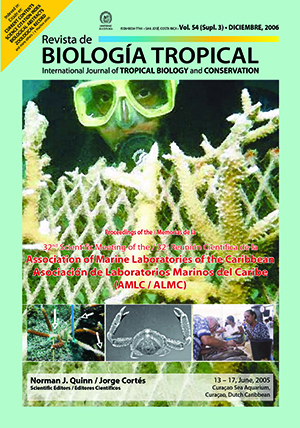Resumen
Se describen tres anomalías: el pico de guadaña en el chinchilín, Quiscalus niger (Boddaert) (Passeriformes: Emberizidae), un patrón de color de corona en el isabelita medioluto, Holacanthus tricolor (Bloch) (Perciformes: Pomacanthidae), y un patrón de color de doble mancha en el vaca blanca, Hypoplectrus unicolor (Walbaum) (Perciformes: Pomacanthidae). Generalmente se piensa que las anomalías en el pico son de origen genético y que los cambios genéticos en la forma del pico pueden ocurrir rápidamente en una población. La anomalía del pico de guadaña demuestra cuan rápido puede ocurrir una modificación drástica del pico. La anomalía del patrón de color de corona es similar a otras marcas distintivas encontradas en otros miembros de este género [isabelita reina, H. ciliaris (Linnaeus) y el híbrido isabelita azul H. ciliaris X H. bermudensis Goode] en el Atlántico occidental tropical y también indica cambios rápidos. Esto es importante porque las especies de este género se distinguen casi solamente por patrones de color. Las anomalías deberían ser registradas ya que podrían darnos algunas pistas acerca del origen genético de las características de las especies. Proponemos que los caracteres potencialmente heredables pueden reconocerse y describirse cuando aparecen en un individuo, antes de que sean heredados a la población, llenando un vacío en nuestro conocimiento de la evolución y la especiación.Citas
Aguilar-Perera, A. 2003. Abundance and distribution of hamlets (Teleostei: Hypoplectrus) in coral reefs off southwestern Puerto Rico: Support for the multispecies hypothesis. Carib. J. Sci. 39: 147-151.
Aguilar-Perera, A. 2004. Variations in morphology and coloration in the Black Hamlet, Hypoplectrus nigricans (Teleostei: Serranidae). Carib. J. Sci. 40: 150-154.
Aguilar-Perera, A. in press. Distribution of Hypoplectrus (Teleostei: Serranidae) in the wider Caribbean Region. J. Biogeogr.
Arendt, J.W. & A.I. Arendt. 1986. Bird deformity in a Pearly-eyed Thrasher from Montserrat, West Indies. N. Amer. Bird Band. 11: 51-52.
Baum, D.A. & A. Larson. 1991. Adaptation reviewed: a phylogenetic methodology for studying character macroevolution. Syst. Zool. 40: 1-18.
Bock, W.J. 1979. The scientific explanation of macroevolutionary change—A reductionistic approach. Bull. Carnegie Mus. Nat. Hist. 13: 20-69.
Bock, W.J. & G. von Wahlert. 1965. Adaptation and the function-form complex. Evolution 19: 269-299.
Blake, C.H. 1957. Diseases and injuries of Jamaican birds. J. Field Ornithol. 28: 157-159.
Bowdish, B.S. 1904. An abnormal bill of Melanerpes portoricensis. Auk 21: 53-55.
Campbell, B. & E. Lack (eds.). 1985. A dictionary of birds. Buteo Books, Vermillion, South Dakota, USA. 670 p.
Craves, J.A. 1994. Passerines with deformed bills. N. Amer. Bird Band. 19: 14-18.
Darwin, C. 1859. The origin of the species by means of natural selection or the preservation of favored races in the struggle for life. 6th ed, Mentor, New York, USA. 495 p.
Domeier, M.L. 1994. Speciation in the serranid fish Hypoplectrus. Bull. Mar. Sci. 54: 103-141.
Fox, W. 1952. Behavioral and evolutionary significance of the abnormal growth of beaks of birds. Condor 54: 160-162.
García-Machado, E., P.P. Chevalier Monteagudo & M. Solignac. 2004. Lack of mtDNA differentiation among hamlets (Hypoplectrus: Serranidae). Mar. Biol. 144: 147-152.
Gould, S.J. 2002. The structure of evolutionary theory. Harvard University, Cambridge, United Kingdom. 1464 p.
Gould, S.J. & R. Lewontin. 1979. The spandrels of San Marco and the Panglossian paradigm: A critique of the adaptation programme. Proc. R. Soc. Lond. B Biol. Sci. 205: 581-598.
Gould, S.J. & E.S. Vrba. 1982. Exaptation—A missing term in the science of form. Paleobiol. 8: 4-15.
Graves, J.E. & R.H. Rosenblatt. 1980. Genetic relationships of the color morphs of the serranid fish Hypoplectrus unicolor. Evolution 34: 240-245.
Green, H.W. 1986. Diet and arboreality in the emerald monitor, Varanus prasinus, with comments on the study of adaptation. Fieldiana Zool. N. Ser. 31: 1-12.
Grizzle, J.M. & E.H. Williams, Jr. 1985. Lesions of a rock beauty, Holacanthus tricolor (Bloch), from Puerto Rico. J. Fish Dis. 8: 129-134.
McCartney, M.A., J. Acevedo, C. Heredia, C. Rico, B. Quenoville, E. Bermingham & W.O. McMillan. 2003. Genetic mosaic in a marine species flock. Molecular Ecol. 12: 2963-2973.
Mutchler, T.M. 1976. Common Grackle with a malformed bill. N. Amer. Bird Band. 1: 145.
Post, W. 1981. The prevalence of some ectoparasites, diseases, and anomalies in the Yellow-shouldered Blackbird. J. Field Ornithol. 52: 16-22.
Raffaele, H., J. Wiley, O. Garrido, A. Keith, & J. Raffaele. 1998. A guide to the birds of the West Indies. Princeton University, Princeton, New Jersey, USA. 511 p.
Ramon, M.L., P.S. Lobel & M.D. Sorenson. 2003. Lack of mitochondrial genetic structure in hamlets (Hypoplectrus spp.): recent speciation or ongoing hybridization. Molecular Ecol. 12: 2975-2980.
Sharp, M.S. & R.L. Neill. 1979. Physical deformities in a population of wintering black birds. Condor 8: 427-430.
Snyder, L.L. 1937. Some measurements and observations from Bronzed Grackles. Canad. Field-Nat. 51: 37-39.
Srinivasa Rao, K. & K. Lakshmi. 1999. Cryptic hybridization in marine fishes: Significance of narrow hybrid zones in identifying stable hybrid populations. J. Nat. Hist. 33: 1237-1259.
Thresher, R.E. 1978. Polymorphism, mimicry and the evolution of the hamlets. Bull. Mar. Sci. 28: 345-353.
Weiner, J. 1995. The beak of the finch: A study of evolution in our time. Alfred A. Knopf, New York, USA. 332 p.
Williams, E.H., Jr. & L. Bunkley-Williams. 2005. Rock Beauty crown pattern, grackle scythebill, and Butter Hamlet double spot anomalies, and their possible genetic significance. Proc. Assoc. Mar. Labs. Carib. 32: 57 (abstract).
Williams, E.H., Jr., L. Bunkley-Williams, C.S. Rogers & R. Fenner. 2006. New geographic records of Hamlets, Hypoplectrus spp. (Serranidae), in the Caribbean Sea. Rev. Biol. Trop. 54 (Suppl. 3): 171-173.
Williams, G.C. 1966. Adaptations and natural selection. Princeton University, Princeton, New Jersey, USA. 307 p.
Williams, L.B. & E.H. Williams, Jr. 1981. Nine new species of Anilocra (Crustacea: Isopoda: Cymothoidae) external parasites of West Indian coral reef fishes. Proc. Biol. Soc. Wash. 94: 1005-1047.
Anonymous. 2003. Additional reports of passerines with deformed bills. Rouge River Bird Observatory, University of Michigan, Dearborn (Downloaded: 14 March 2003, http://www.umd.umic.edu/dept/rouge_ river/bills.html).
Comentarios

Esta obra está bajo una licencia internacional Creative Commons Atribución 4.0.
Derechos de autor 2007 Revista de Biología Tropical






